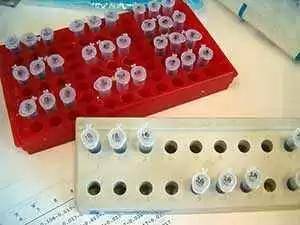Celiac.com 09/30/2002 - As reported in the September 27, 2002 issue of Science, Dr. Chaitan Khosla, professor of chemistry and chemical engineering at Stanford University, and colleagues have identified the specific protein fragment that causes intestinal damage when people with celiac disease eat grains such as wheat, rye, and barley. Graduate student Lu Shan from the Stanford team was able to identify the specific protein fragment in gluten that triggers the damaging attack by T-cells in individuals with the disease. The key fragment is made up of 33 amino acids that are normally broken down in the digestive systems of healthy individuals, but not in those with celiac disease.
Celiac.com Sponsor (A12):
In addition to this discovery, the Stanford team is also beginning their search for a celiac disease cure. To that end they have developed an enzyme treatment that renders the newly discovered harmful amino acid sequence in gluten harmless in the guts of test animals, and hope that it will do the same in humans. Several more years of research must be done in order to determine if it will be effective in humans. Dr. Khosla warns against undue optimism regarding the preliminary results of their new enzyme therapy, and stresses that it is too early to raise the hopes of those with celiac disease.
To fund the teams future research efforts Dr. Khosla and colleagues have established the Open Original Shared Link, whose goal is finding a cure for the disease. The foundation must raise two million dollars by 2003 in order to begin serious scientific research to that end. Anyone interested in making a tax deductible contribution should go to their Web site: Open Original Shared Link.
I personally believe that the work of the Celiac Sprue Research Foundation represents our best shot at a cure for celiac disease.
- Scott Adams, Celiac.com.
Medline Abstract:
Intestinal Digestive Resistance of Immunodominant Gliadin Peptides.
Am J Physiol Gastrointest Liver Physiol 2002 Oct;283(4):G996-G1003
Hausch F, Shan L, Santiago NA, Gray GM, Khosla C.
Department of Chemical Engineering, Stanford University, Stanford, California 94305-5025.
Two recently identified immunodominant epitopes from alpha-gliadin account for most of the stimulatory activity of dietary gluten on intestinal and peripheral T lymphocytes in patients with celiac sprue. The proteolytic kinetics of peptides containing these epitopes were analyzed in vitro using soluble proteases from bovine and porcine pancreas and brush-border membrane vesicles from adult rat intestine. We showed that these proline-glutamine-rich epitopes are exceptionally resistant to enzymatic processing. Moreover, as estimated from the residual peptide structure and confirmed by exogeneous peptidase supplementation, dipeptidyl peptidase IV and dipeptidyl carboxypeptidase I were identified as the rate-limiting enzymes in the digestive breakdown of these peptides. A similar conclusion also emerged from analogous studies with brush-border membrane from a human intestinal biopsy. Supplementation of rat brush-border membrane with trace quantities of a bacterial prolyl endopeptidase led to the rapid destruction of the immunodominant epitopes in these peptides. These results suggest a possible enzyme therapy strategy for celiac sprue, for which the only current therapeutic option is strict exclusion of gluten-containing food.
PMID: 12223360






Recommended Comments
There are no comments to display.